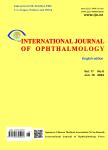Foveal regeneration after resolution of cystoid macular edema without and with internal limiting membrane detachment:presumed role of glial cells for foveal structure stabilization
作者机构:Department of Ophthalmology and Eye HospitalUniversity of LeipzigLeipzig 04103Germany Helios Klinikum AueAue 08280Germany
出 版 物:《International Journal of Ophthalmology(English edition)》 (国际眼科杂志(英文版))
年 卷 期:2021年第14卷第6期
页 面:818-833页
核心收录:
学科分类:1002[医学-临床医学] 100212[医学-眼科学] 10[医学]
主 题:fovea cystoid macular edema internal limiting membrane detachment Müller cell sheen dystrophy Müller glia astrocytes
摘 要:AIM: To document with spectral-domain optical coherence tomography the morphological regeneration of the fovea after resolution of cystoid macular edema(CME) without and with internal limiting membrane(ILM) detachment and to discuss the presumed role of the glial scaffold for foveal structure stabilization. METHODS: A retrospective case series of 38 eyes of 35 patients is described. Of these, 17 eyes of 16 patients displayed foveal regeneration after resolution of CME, and 6 eyes of 6 patients displayed CME with ILM detachment. Eleven eyes of 9 patients displayed other kinds of foveal and retinal disorders associated with ILM detachment. RESULTS: The pattern of edematous cyst distribution, with or without a large cyst in the foveola and preferred location of cysts in the inner nuclear layer or Henle fiber layer(HFL), may vary between different eyes with CME or in one eye during different CME episodes. Large cysts in the foveola may be associated with a tractional elevation of the inner foveal layers and the formation of a foveoschisis in the HFL. Edematous cysts are usually not formed in the ganglion cell layer. Eyes with CME and ILM detachment display a schisis between the detached ILM and nerve fiber layer(NFL) which is traversed by Müller cell trunks. ILM detachment was also found in single eyes with myopic traction maculopathy, macular pucker, full-thickness macular holes, outer lamellar holes, and glaucomatous parapapillary retinoschisis, and in 3 eyes with Müller cell sheen dystrophy(MCSD). As observed in eyes with MCSD, cellophane maculopathy, and macular pucker, respectively, fundus light reflections can be caused by different highly reflective membranes or layers: the thickened and tightened ILM which may or may not be detached from the NFL, the NFL, or idiopathic epiretinal membranes. In eyes with short single or multiple CME episodes, the central fovea regenerated either completely, which included the disappearance of irregularities of the photoreceptor l



